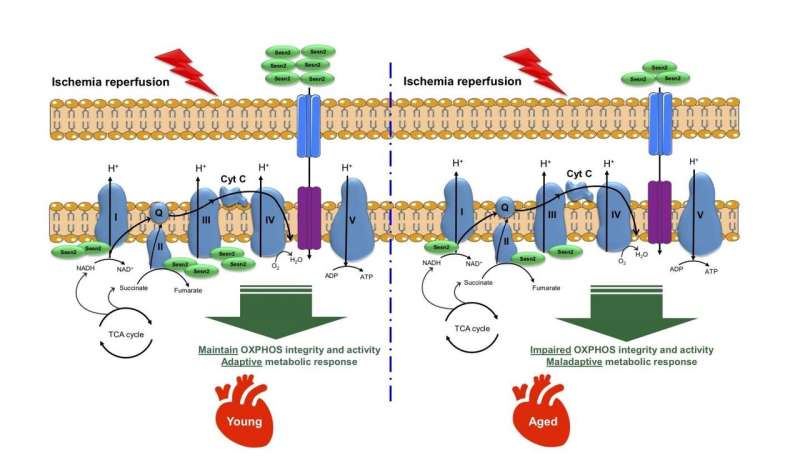Graphical abstract demonstrates decline of Sesn2 presence in older hearts. Credit: University of South Florida
A team of researchers at the University of South Florida Department of Surgery has made a key discovery as to why we become more susceptible to heart disease as we age. The human body, especially the heart, is dependent on the mitochondria, the part of the cell responsible for producing energy to maintain organ function. The protein, Sesn2, is located inside the mitochondria and plays a pivotal role in protecting the heart from stress.
Dr. Ji Li, professor of surgery and molecular pharmacology and physiology, and his colleagues found levels of Sesn2 diminish over time, which weakens the heart and can cause it to lose functionality. His group's study published in Redox Biology, reports that an insufficient level of Sesn2 is the reason older individuals are at greater risk of heart attack and other heart complications. This indicates stabilizing the protein could be the answer to maintaining a healthy heart.
It's common for people who've experienced cardiac arrest to have a stent inserted into a blood vessel to relieve obstruction or are prescribed medications designed to prevent blood clots. While they may offer rapid relief, these treatments can cause further injury to the heart. There are currently no known treatments available to prevent those potential side effects. Li's group, which includes the University of Louisville, found focusing on Sesn2 can keep mitochondria functional integrity, offsetting such complications.
Through biochemical analysis and high-powered microscopes, they could see Sesn2 deficiency caused cells to die in older mice, inducing heart attack. Li is now in the process of confirming their findings on human hearts provided by LifeLink, which helps facilitate organ donations for transplantation and research. Li expects to have those results available in the next couple of years.
"The age-related Sesn2 is a critical player in mitochondria," Li said. "Maintaining the cardiac Sesn2 levels could make the heart energic and against age-related heart disease."
The uncovering of Sesn2's significance helps advance the development of new therapeutic treatments. Li says the method would likely be a familiar one. Gene therapy or pharmacological approach could be considered to maintain the cardiac Sesn2 signaling pathway to strengthen the heart in aging.
More information: Di Ren et al. Sestrin2 maintains OXPHOS integrity to modulate cardiac substrate metabolism during ischemia and reperfusion, Redox Biology (2020). DOI: 10.1016/j.redox.2020.101824
Provided by University of South Florida






















